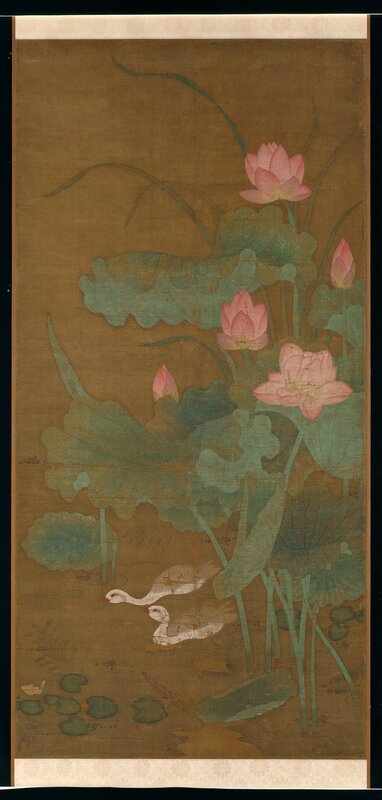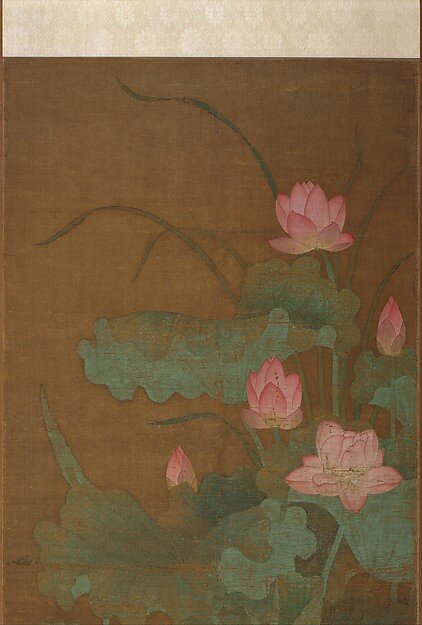Unidentified Artist , active ca. 1300, Lotus and waterbirds, ca. 1300, Yuan dynasty (1271–1368)
Unidentified Artist , active ca. 1300, Lotus and waterbirds 元 佚名 蓮花圖 軸, ca. 1300, Yuan dynasty (1271–1368). Pair of hanging scrolls; ink and color on silk. Image (each): 55 3/4 x 26 3/4 in. (141.6 x 67.9 cm) Overall with mounting (each): 107 1/2 x 27 1/4 in. (273.1 x 69.2 cm) Overall with knobs (each): 107 1/2 x 27 3/4 in. (273.1 x 70.5 cm). The Metropolitan Museum of Art. Purchase, The Dillon Fund Gift, 1988 (1988.155a, b) © 2000–2016 The Metropolitan Museum of Art.
Imported from India, the lotus—growing from the slime of a pond, its blossoms blooming unsullied—was linked to Buddhist images of purity and rebirth. By the thirteenth century, naturalistic depictions of lotus in different seasons also evoked the ephemeral nature of physical beauty. This large-scale decorative work is by a professional painter of the Piling School, situated near Changzhou, Jiangsu Province. The midsummer scene (on the right) shows lotus flowers in early stages of budding and bloom, while the autumnal scene (on the left) shows its later stages: petals falling, leaves turning brown, and seed pods ripening. The newly sprouted water reeds of midsummer also contrast with the late-blooming water plant and the smartweed that has gone to seed, while the busy activity of a pair of ducks skimming the water for food on the right is juxtaposed with two egrets resting quietly on the left.
This work is exhibited in the "Masterpieces of Chinese Painting from the Metropolitan Collection" exhibition, on view through October 11th, 2016.

/https%3A%2F%2Fprofilepics.canalblog.com%2Fprofilepics%2F1%2F0%2F100183.jpg)
/https%3A%2F%2Fstorage.canalblog.com%2F03%2F02%2F119589%2F96711876_o.jpg)
/https%3A%2F%2Fstorage.canalblog.com%2F11%2F31%2F119589%2F94773502_o.jpg)
/https%3A%2F%2Fstorage.canalblog.com%2F20%2F83%2F119589%2F94772815_o.jpg)
/https%3A%2F%2Fstorage.canalblog.com%2F26%2F72%2F119589%2F75604929_o.jpg)
/https%3A%2F%2Fstorage.canalblog.com%2F59%2F60%2F119589%2F26458628_o.jpg)





/image%2F1371349%2F20240406%2Fob_b6629b_434639765-1646435522793127-51895182157.jpg)
/image%2F1371349%2F20240406%2Fob_53c757_435758154-1646430439460302-28934857903.jpg)
/image%2F1371349%2F20240406%2Fob_f762e5_435810099-1646427029460643-74606500582.jpg)
/image%2F1371349%2F20240316%2Fob_974d50_171-1.jpg)